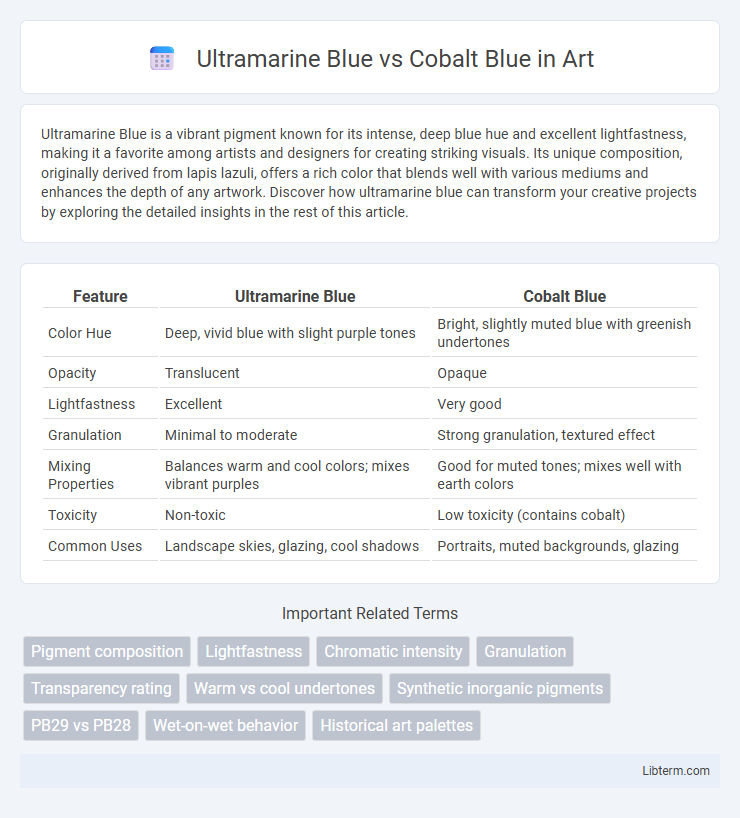Ultramarine Blue is a vibrant pigment known for its intense, deep blue hue and excellent lightfastness, making it a favorite among artists and designers for creating striking visuals. Its unique composition, originally derived from lapis lazuli, offers a rich color that blends well with various mediums and enhances the depth of any artwork. Discover how ultramarine blue can transform your creative projects by exploring the detailed insights in the rest of this article.
Table of Comparison
| Feature | Ultramarine Blue | Cobalt Blue |
|---|---|---|
| Color Hue | Deep, vivid blue with slight purple tones | Bright, slightly muted blue with greenish undertones |
| Opacity | Translucent | Opaque |
| Lightfastness | Excellent | Very good |
| Granulation | Minimal to moderate | Strong granulation, textured effect |
| Mixing Properties | Balances warm and cool colors; mixes vibrant purples | Good for muted tones; mixes well with earth colors |
| Toxicity | Non-toxic | Low toxicity (contains cobalt) |
| Common Uses | Landscape skies, glazing, cool shadows | Portraits, muted backgrounds, glazing |
Introduction: Understanding Ultramarine Blue and Cobalt Blue
Ultramarine Blue, derived from the semi-precious stone lapis lazuli, is known for its deep, vibrant hue and excellent color stability in artworks. Cobalt Blue, made from cobalt salts, offers a slightly lighter, more muted shade with strong opacity and high resistance to fading. Both pigments are essential in art and design, each providing unique qualities that influence color mixing and visual impact.
Historical Origins and Discovery
Ultramarine Blue, originally derived from the semi-precious stone lapis lazuli, was first mined in Afghanistan over 6,000 years ago and prized for its vivid, deep blue hue in Renaissance art. Cobalt Blue, discovered in the early 19th century by Swedish chemist Georg Brandt, was the first stable synthetic blue pigment made from cobalt salts, revolutionizing pigment availability and consistency. The historical significance of Ultramarine Blue lies in its rarity and expense, while Cobalt Blue marked a breakthrough in industrial pigment production for artists worldwide.
Chemical Composition and Production
Ultramarine Blue primarily consists of sodium aluminum sulfosilicate, derived from the mineral lazurite and produced through a high-temperature sintering process involving kaolin, sulfur, and sodium carbonate. Cobalt Blue is chemically cobalt(II) aluminate, synthesized via a solid-state reaction of cobalt oxide and aluminum oxide at elevated temperatures. The distinct chemical compositions result in Ultramarine Blue's deep, vibrant hue and Cobalt Blue's intense, stable pigment suitable for various artistic applications.
Color Characteristics and Visual Differences
Ultramarine Blue exhibits a deep, rich hue with a slight purplish undertone, providing intense vibrancy and warmth ideal for creating atmospheric depth in artwork. Cobalt Blue, by contrast, presents a brighter, more opaque shade with cooler, greenish undertones, offering excellent lightfastness and a smoother matte finish. These visual differences make Ultramarine Blue preferred for bold, expressive strokes, while Cobalt Blue suits detailed work requiring subtle tonal variation and consistent opacity.
Lightfastness and Permanence
Ultramarine Blue exhibits excellent lightfastness and permanence, making it highly resistant to fading over time, especially under natural light. Cobalt Blue also offers strong lightfastness but can be slightly less stable when exposed to intense, prolonged ultraviolet rays. Both pigments are favored in fine art for their durability, with Ultramarine Blue often preferred for archival-quality works requiring maximum longevity.
Mixing Properties and Compatibility
Ultramarine Blue offers excellent mixing properties with warm tones, producing vibrant purples and rich earthy hues, while Cobalt Blue blends seamlessly with cooler colors to yield soft, muted tints and smooth gradations. Ultramarine's granulating texture enhances textural effects in mixtures, contrasting with Cobalt Blue's durability and opacity that maintain color stability in layered applications. Both pigments exhibit strong lightfastness, but Ultramarine Blue's slightly higher tinting strength makes it favorable for dynamic color interactions in artistic palettes.
Uses in Fine Art Painting
Ultramarine Blue is prized in fine art for its deep, vibrant hue and excellent lightfastness, making it ideal for creating rich skies and shadows in oil and acrylic paintings. Cobalt Blue offers a cooler, slightly more opaque tone favored for mixing delicate greens and atmospheric effects in watercolor and oil mediums. Artists often select Ultramarine for its strong tinting strength and luminescence, while Cobalt Blue is chosen for its stability and subtle, soft color transitions.
Applications in Design and Industry
Ultramarine Blue offers intense, vibrant hues ideal for fine art painting, digital design, and print media due to its excellent lightfastness and strong tinting strength. Cobalt Blue, prized for its stability and subdued tone, is widely used in ceramics, glass manufacturing, and industrial coatings where heat resistance and durability are essential. Both pigments serve critical roles in creative and manufacturing sectors, balancing aesthetic appeal and functional performance.
Cost and Availability Comparison
Ultramarine Blue is generally more affordable and widely available compared to Cobalt Blue, making it a popular choice for artists on a budget. Cobalt Blue tends to be pricier due to its complex production process and the use of cobalt minerals, which are less common. Both pigments are commonly stocked in art supply stores, but Ultramarine Blue's lower cost and broader accessibility contribute to its prevalence in diverse artistic applications.
Choosing the Right Blue for Your Project
Ultramarine Blue offers a rich, deep hue with excellent transparency, making it ideal for glazing and layering in watercolor and oil painting. Cobalt Blue provides a lighter, more opaque finish with strong lightfastness, perfect for mixing vibrant greens and bright skies. Consider the medium and desired effect: choose Ultramarine for intense, warm blues and Cobalt for softer, cooler tones with high durability.
Ultramarine Blue Infographic

 libterm.com
libterm.com